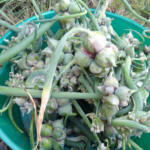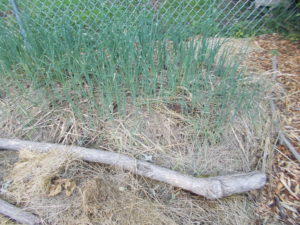It is also called tree onion, or Egyptian walking onion.
In spring 2014, my husband and I visited his family in north of Iowa. I remarked some green stalk growing in the snow in my husband’s grandmother’s place. I was surprised that a flower was so hardy to grow so early in spring. So I asked my aunt in law what flower was it? She looked at me and said it was winter onion. She tried to give me one but failed to take the bulb out with the root. So she advised me to eat it and later they would hoe some for me to plant. I knew a little about Egyptian onion and I planned to order from a nursery that year for my garden. It was my first garden and we were living in a rental duplex. The landlord gave me permission to garden. When I got home I planted the bulb my aunt in-law gave me. Later around late spring, we went back to my in-laws and my mother in-law hoe a lot of Egyptian onions for me to take home. Her mom has more than what she could eat. I don’t know for how long they have it in the family. When I go home I planted them. I even put many in the same whole as I ran out space. I even put some in the compost pile under a pile of food scraps.
The one in the garden grew well. I harvested them in early fall. I kept most of them for replanting. We moved in September that year to our house where I planted them in the garden. During our move, I took my compost along. As I bagged the compost, I remarked that the Egyptian onions I threw in the compost bin for at least 4 months, stayed alive and grew there with white stalks as they didn’t have access to light. I took them along and knew that point that Egyptian onion at least the variety I have can not be killed easily.
I have been growing them since.
Every part of Egyptian onion is edible including the bulbils, the stalks, and the bulb.
So if you have excess of them, don’t throw them in the compost pile like I did. Eat them.
Egyptian onion can be planted in spring or fall. The bulbs underground can be harvested between June and July where they go dormant. They sprout in late July to August. They grow till end of November when they die back to the ground in our zone 5. They are the first greens in early spring. Egyptian onion provides green stalks for cooking from early spring to late November with one month break in summer where their bulbs can be harvested for eating or curing. The bulbs don’t do well in storage. It is better to leave them in the ground and take as needed. I harvest the stalks, chop them up and freeze in one gallon zip bag for winter use. I dig some bulbs in late summer and let it cure in a shady area for eating but most of them go back in the ground. You don’t need to dry before planting. You can dig some and replant right away. They do well left in the ground during their dormancy period. They don’t rot like red shallot or potato onion when it rains a lot during the same time frame. Egyptian onion bulb can be divided underground into 2-3 but generally not more than that. They don’t need to be harvested in summer cured and planted in fall like other perennial onions. I leave them in the ground year round. I only dig the ones I want to relocate to make path in the garden. I remarked that bulbs left in the ground for more than a year grow bigger stalks, bigger bulbs, and bigger bulbils. I still have the patch I planted back in October 2014 when we first moved to our house. These grow big stalks.
Egyptian onion grow onion bulbs in the ground and small onions with hard skin on top of the stalks called bulbils. In spring you can harvest stalks. Leave 2 young stalks for their photosynthesis. Eat the old stalks. The stalks get longer, bend over and touch the ground with the tip which tend to brown. Eat those first.
When the main stalks that would support the bulbils grow out, you could recognize them as they are hard. Don’t cut them for eating. You won’t have bulbils if you cut them. The main stalks do not soften in cooking. You can harvest them when harvesting the bulbils and store the main stalks in the freezer to make vegetable broth.
Each bulb grow one main stalk that would support the bulbils. Many bulbils grow on one stalk. Often time the main stalks would fall over allowing the bulbils to touch the ground and root. On the stalks that stay upright, their bulbils after a period of time would shoot root out and start to grow as well. I like to harvest the bulbils and replant them. When I am not ready to plant I keep them in a box in my garage and dry in a shady area until the ones in the ground start to sprout. Usually, a bulbil planted doesn’t grow bulbils the first year. However, I remarked that big bulbils produce bulbils in their first year and small bulbils don’t. Small or big bulbils produce stalks for your eating. Regardless of what other people say, my Egyptian onion produce flower on the same stalks next to the bulbils but their flower is a little different from onion flower.
You can leave your Egyptian onion in the ground year after year and occasionally dig some out to avoid overclouding them. Also it is a good idea to remove the bulbils and replant them. I would suggest you plant them a foot apart and allow them to fill in. Their stalks are a foot long and tend to naturally plant the bulbils a foot away from the mother bulb.
Egyptian onion or winter onion is by far my favorite perennial onion as they are planted once and left in the ground all year round. No need to dig and cure for fall planting. They have short dormancy period and don’t stay in the ground for long before sprouting in early fall. The bulbs can be left in the ground and the stalks can be used like green onion in cooking and fresh eating. They produce bulbils that can be planted to increase their number. Use them in a sustainable way and you would always have onion in your garden. You don’t need to buy them every year to plant like regular onion. You only buy them once and they would fill your garden over time and supply you with onion all year round. They are rare to find as they are not sold at the grocery store. Last year I ordered regular onion sets and planted in spring. They grew into small onions when I was expecting big onions like store bought onions. It was a waste of money and I decided I would order onion seeds to start them indoor this winter. When I placed my order this week, I didn’t buy onion seeds as I realized that I didn’t need to waste my money and time trying to grow regular onions. I should spend my time nurturing my perennial onions and get accustomed to use them. I have not purchased regular onions from the grocery store for 2 years. I shouldn’t try to grow them either. They can be replaced by Egyptian onion whether in cooked or fresh eating dishes. They are many varieties of Egyptian onions. Two years ago I ordered few different varieties from a seed preservation website. But none of my order was shipped to me. I couldn’t reach anyone from the company to discuss my order either. I am glad I have the variety that is been grown in my husband’s family.


